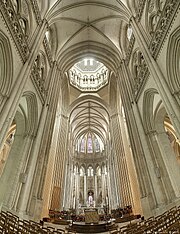What jumped out at me, the more education I got, was how much there is to know, and how little of that any one person can touch even in a lifetime. There’s a vast world of knowledge in just one small corner of one subject– say learning all about jazz as a music major. There’s jazz history, jazz musicians, jazz theory, arranging, instrumentation, the evolution from one style of jazz to another, a wealth of scales and arpeggios and chord structures and progressions to learn, to use either as a composer or as an improvising musician. Now expand jazz to the whole field of music. Now expand music to all of a society’s culture in general– art, literature, fashion. Add to that sciences– medicine, physics, chemistry and more– and a multitude of skills necessary to keep society running smoothly. If you love to learn, you will never run out of things to study.
Today’s question was another seemingly simple question: what might the chapel at Castle MacDougall look like? In my initial draft, I called it ‘gothic.’ But then I decided I better check the years in which architecture was actually considered ‘gothic.’ It turns out the years are accurate: gothic architecture began in the 1100′s in France, and spread out to the rest of Europe, continuing into the 1500′s.
But Europe is a broad term, and it turns out even gothic is a relatively broad term– if you want to be specific (or is that picky) about it. I like to be, and found, in the process, that there is great regional variation in what the word means.
A gothic cathedral in France, for example, would likely be built out of limestone, and feature a narrow transept, the crossarm which divides the long nave (where the pews are) from the choir. Its eastern end– the choir– is likely to be polygonal with a ring of chapels (a ‘chevet.’) The cathedrals of this time in France are more often found as ruins out in the country– because the prevalent order, the Cistercians, liked to build farther out.
A gothic cathedral in England, by contrast, may well be built of not only limestone, but red sandstone, dark green Purbeck marble, and timbered “hammer-beam” roofs. Its transept is likely to have strongly projecting arms, compared to France’s rather narrow ones, its eastern end is going to be square, and the whole structure is probably going to be in a town, where England’s dominant order, the Benedictines, liked to build.
Typical of gothic church construction are pointed arches, ribbed vaults, and flying buttresses. They exaggerate height and emphasize light. I found this particularly interesting, as the word gothic, today, tends to have darker connotations. Gothic fiction, for example, combines romance and horror. A wikipedia article on gothic fiction says: The ruins of gothic buildings gave rise to multiple linked emotions by representing the inevitable decay and collapse of human creations. And: Gothic writers often associated medieval buildings with what they saw as a dark and terrifying period. Gothic fiction features such ‘light’ themes as hauntings, madness, doubles, decay, death, mystery. Where are you, Edgar Allen Poe! The cast includes a variety of madmen, evil-doers, and creatures of the night such as werewolves, demons and vampires, who you would most likely not want as your neighbors. (Then again, maybe you would.) (http://en.wikipedia.org/wiki/Gothic_fiction)
Gothic fashion is typically dark, even morbid.
The word gothic, as applied to the architecture itself, was originally an insult, meaning barbaric or rude.
And yet, with the word gothic having so many dark and negative connotations, the hallmarks of gothic architecture are light and height. Solid walls have been replaced with rows of roof-supporting columns that let light flow through the building. Ceilings soar high, with clerestory windows that pour in light. The height and vertical emphasis give a feeling of lifting to Heaven, or airiness and lightness (in the other sense of the word.) I personally find gothic cathedrals to be incredibly beautiful.

Gothic Cathedral
…all of which brings us back to the chapel at Castle MacDougall.
A castle chapel is not a cathedral. What applies to Europe between the 12th and 16th centuries is not necessarily accurate for the west of Scotland in 1314. And even if it does, could the thieving MacDougalls, the Darth Vader of the 14th century, really have a beautiful, light and airy chapel? It would be an interesting contrast to the character of the MacDougall. Maybe that’s exactly what he will have. Then again, maybe not.
It’s been fun, but right now, I’m back at square one. Next I’m going to research specific churches of the thirteenth and fourteenth century Highlands. And we’ll see what MacDougall’s chapel looks like in my head in a few days. At least I know what Amy finds there!
What do you think MacDougall’s chapel should look like?
![]() Tweet This Post
Tweet This Post
Tags: Benedictines, cathedrals, churches, Cistercian, gothic, medieval, Research


